Body Mass Index in Epidemic Assesment
VerifiedAdded on 2022/08/25
|8
|1870
|15
AI Summary
Contribute Materials
Your contribution can guide someone’s learning journey. Share your
documents today.
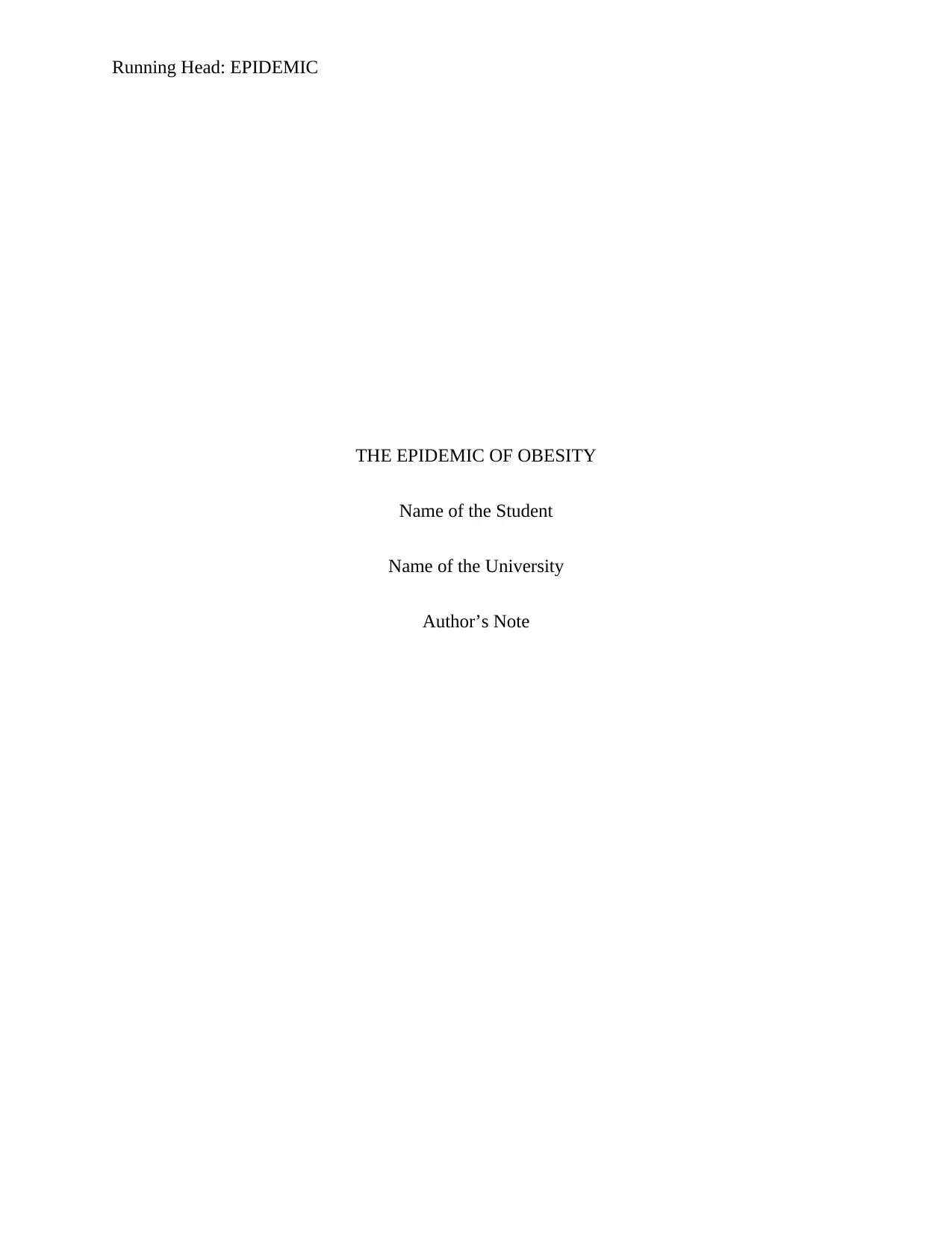
Running Head: EPIDEMIC
THE EPIDEMIC OF OBESITY
Name of the Student
Name of the University
Author’s Note
THE EPIDEMIC OF OBESITY
Name of the Student
Name of the University
Author’s Note
Secure Best Marks with AI Grader
Need help grading? Try our AI Grader for instant feedback on your assignments.
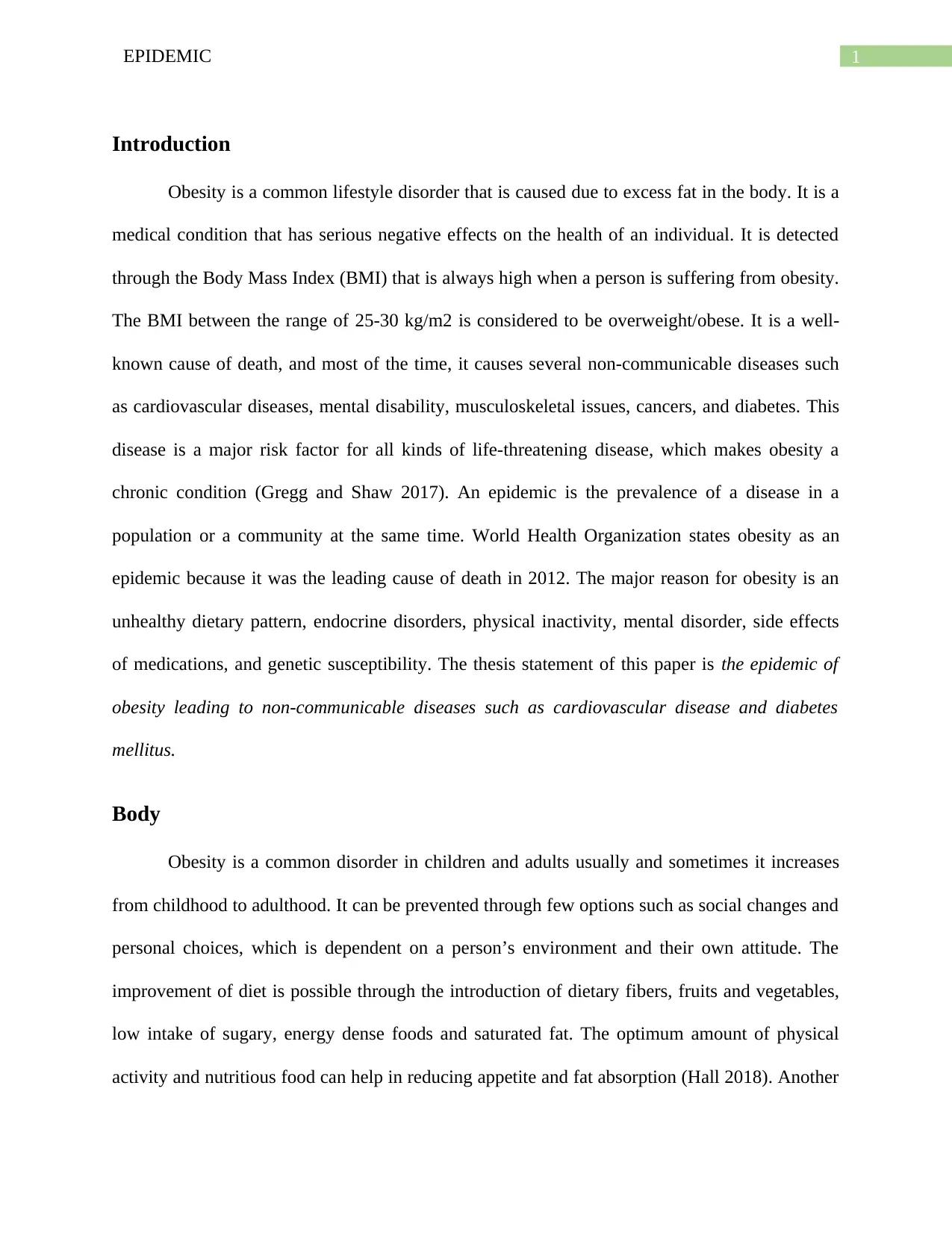
1EPIDEMIC
Introduction
Obesity is a common lifestyle disorder that is caused due to excess fat in the body. It is a
medical condition that has serious negative effects on the health of an individual. It is detected
through the Body Mass Index (BMI) that is always high when a person is suffering from obesity.
The BMI between the range of 25-30 kg/m2 is considered to be overweight/obese. It is a well-
known cause of death, and most of the time, it causes several non-communicable diseases such
as cardiovascular diseases, mental disability, musculoskeletal issues, cancers, and diabetes. This
disease is a major risk factor for all kinds of life-threatening disease, which makes obesity a
chronic condition (Gregg and Shaw 2017). An epidemic is the prevalence of a disease in a
population or a community at the same time. World Health Organization states obesity as an
epidemic because it was the leading cause of death in 2012. The major reason for obesity is an
unhealthy dietary pattern, endocrine disorders, physical inactivity, mental disorder, side effects
of medications, and genetic susceptibility. The thesis statement of this paper is the epidemic of
obesity leading to non-communicable diseases such as cardiovascular disease and diabetes
mellitus.
Body
Obesity is a common disorder in children and adults usually and sometimes it increases
from childhood to adulthood. It can be prevented through few options such as social changes and
personal choices, which is dependent on a person’s environment and their own attitude. The
improvement of diet is possible through the introduction of dietary fibers, fruits and vegetables,
low intake of sugary, energy dense foods and saturated fat. The optimum amount of physical
activity and nutritious food can help in reducing appetite and fat absorption (Hall 2018). Another
Introduction
Obesity is a common lifestyle disorder that is caused due to excess fat in the body. It is a
medical condition that has serious negative effects on the health of an individual. It is detected
through the Body Mass Index (BMI) that is always high when a person is suffering from obesity.
The BMI between the range of 25-30 kg/m2 is considered to be overweight/obese. It is a well-
known cause of death, and most of the time, it causes several non-communicable diseases such
as cardiovascular diseases, mental disability, musculoskeletal issues, cancers, and diabetes. This
disease is a major risk factor for all kinds of life-threatening disease, which makes obesity a
chronic condition (Gregg and Shaw 2017). An epidemic is the prevalence of a disease in a
population or a community at the same time. World Health Organization states obesity as an
epidemic because it was the leading cause of death in 2012. The major reason for obesity is an
unhealthy dietary pattern, endocrine disorders, physical inactivity, mental disorder, side effects
of medications, and genetic susceptibility. The thesis statement of this paper is the epidemic of
obesity leading to non-communicable diseases such as cardiovascular disease and diabetes
mellitus.
Body
Obesity is a common disorder in children and adults usually and sometimes it increases
from childhood to adulthood. It can be prevented through few options such as social changes and
personal choices, which is dependent on a person’s environment and their own attitude. The
improvement of diet is possible through the introduction of dietary fibers, fruits and vegetables,
low intake of sugary, energy dense foods and saturated fat. The optimum amount of physical
activity and nutritious food can help in reducing appetite and fat absorption (Hall 2018). Another
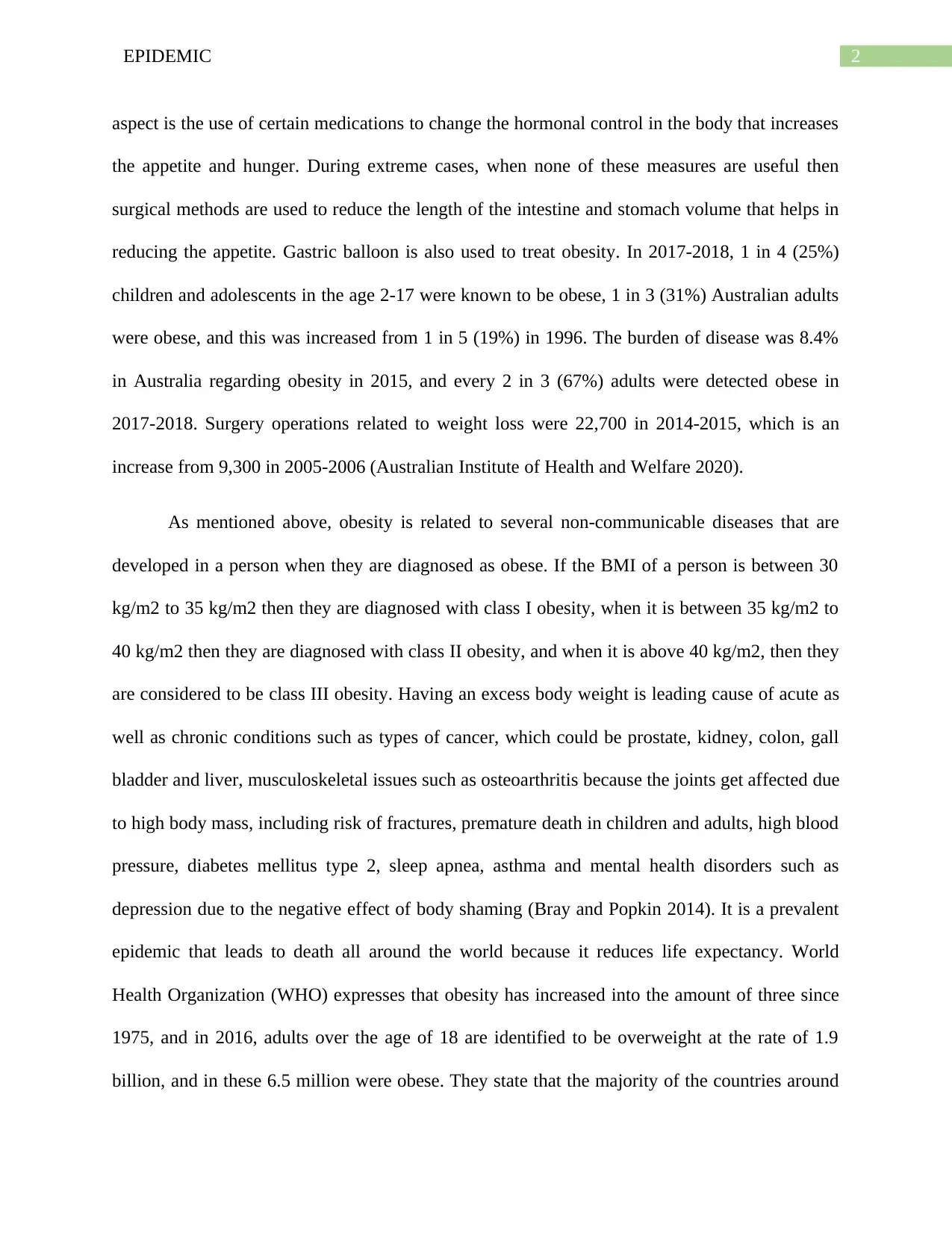
2EPIDEMIC
aspect is the use of certain medications to change the hormonal control in the body that increases
the appetite and hunger. During extreme cases, when none of these measures are useful then
surgical methods are used to reduce the length of the intestine and stomach volume that helps in
reducing the appetite. Gastric balloon is also used to treat obesity. In 2017-2018, 1 in 4 (25%)
children and adolescents in the age 2-17 were known to be obese, 1 in 3 (31%) Australian adults
were obese, and this was increased from 1 in 5 (19%) in 1996. The burden of disease was 8.4%
in Australia regarding obesity in 2015, and every 2 in 3 (67%) adults were detected obese in
2017-2018. Surgery operations related to weight loss were 22,700 in 2014-2015, which is an
increase from 9,300 in 2005-2006 (Australian Institute of Health and Welfare 2020).
As mentioned above, obesity is related to several non-communicable diseases that are
developed in a person when they are diagnosed as obese. If the BMI of a person is between 30
kg/m2 to 35 kg/m2 then they are diagnosed with class I obesity, when it is between 35 kg/m2 to
40 kg/m2 then they are diagnosed with class II obesity, and when it is above 40 kg/m2, then they
are considered to be class III obesity. Having an excess body weight is leading cause of acute as
well as chronic conditions such as types of cancer, which could be prostate, kidney, colon, gall
bladder and liver, musculoskeletal issues such as osteoarthritis because the joints get affected due
to high body mass, including risk of fractures, premature death in children and adults, high blood
pressure, diabetes mellitus type 2, sleep apnea, asthma and mental health disorders such as
depression due to the negative effect of body shaming (Bray and Popkin 2014). It is a prevalent
epidemic that leads to death all around the world because it reduces life expectancy. World
Health Organization (WHO) expresses that obesity has increased into the amount of three since
1975, and in 2016, adults over the age of 18 are identified to be overweight at the rate of 1.9
billion, and in these 6.5 million were obese. They state that the majority of the countries around
aspect is the use of certain medications to change the hormonal control in the body that increases
the appetite and hunger. During extreme cases, when none of these measures are useful then
surgical methods are used to reduce the length of the intestine and stomach volume that helps in
reducing the appetite. Gastric balloon is also used to treat obesity. In 2017-2018, 1 in 4 (25%)
children and adolescents in the age 2-17 were known to be obese, 1 in 3 (31%) Australian adults
were obese, and this was increased from 1 in 5 (19%) in 1996. The burden of disease was 8.4%
in Australia regarding obesity in 2015, and every 2 in 3 (67%) adults were detected obese in
2017-2018. Surgery operations related to weight loss were 22,700 in 2014-2015, which is an
increase from 9,300 in 2005-2006 (Australian Institute of Health and Welfare 2020).
As mentioned above, obesity is related to several non-communicable diseases that are
developed in a person when they are diagnosed as obese. If the BMI of a person is between 30
kg/m2 to 35 kg/m2 then they are diagnosed with class I obesity, when it is between 35 kg/m2 to
40 kg/m2 then they are diagnosed with class II obesity, and when it is above 40 kg/m2, then they
are considered to be class III obesity. Having an excess body weight is leading cause of acute as
well as chronic conditions such as types of cancer, which could be prostate, kidney, colon, gall
bladder and liver, musculoskeletal issues such as osteoarthritis because the joints get affected due
to high body mass, including risk of fractures, premature death in children and adults, high blood
pressure, diabetes mellitus type 2, sleep apnea, asthma and mental health disorders such as
depression due to the negative effect of body shaming (Bray and Popkin 2014). It is a prevalent
epidemic that leads to death all around the world because it reduces life expectancy. World
Health Organization (WHO) expresses that obesity has increased into the amount of three since
1975, and in 2016, adults over the age of 18 are identified to be overweight at the rate of 1.9
billion, and in these 6.5 million were obese. They state that the majority of the countries around
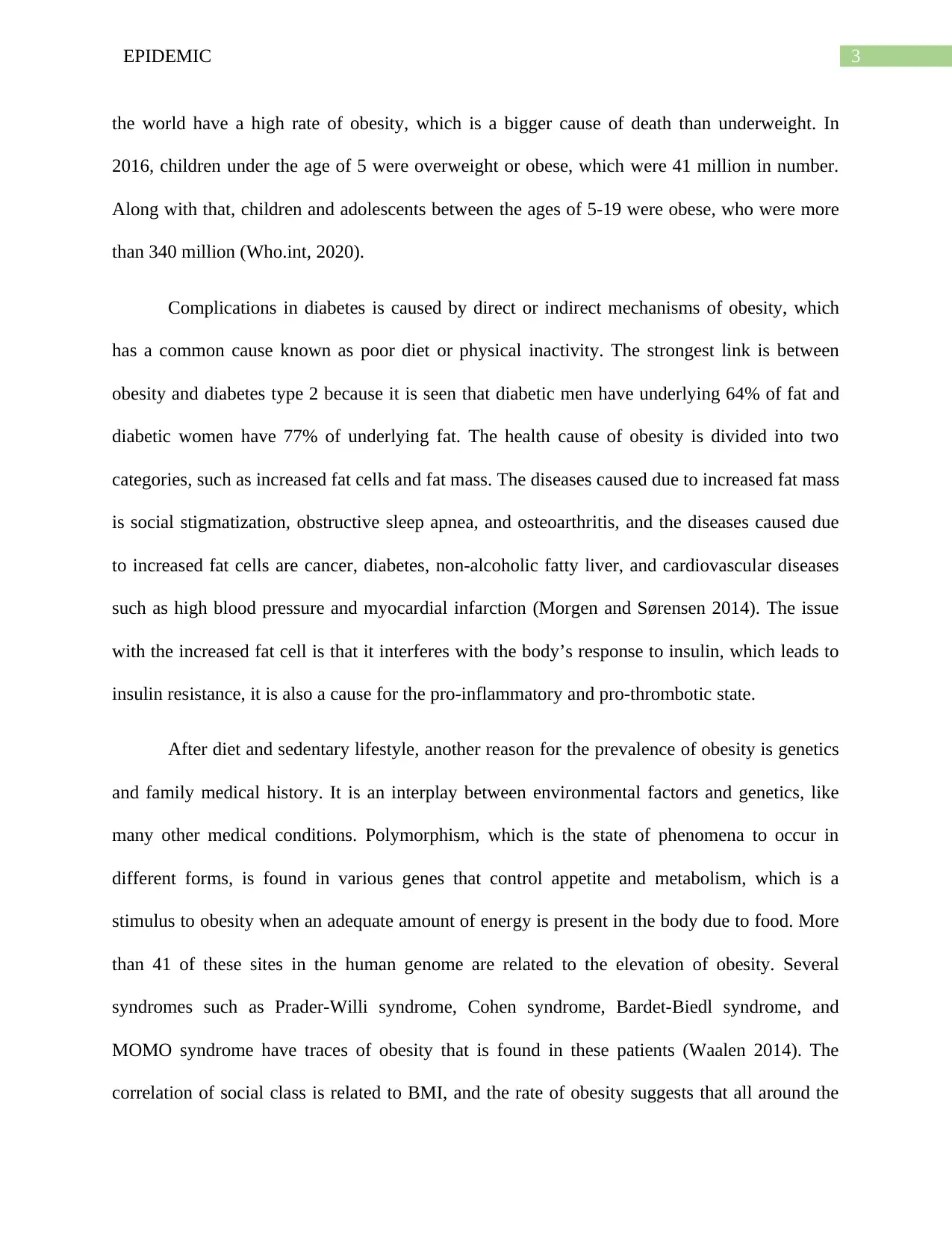
3EPIDEMIC
the world have a high rate of obesity, which is a bigger cause of death than underweight. In
2016, children under the age of 5 were overweight or obese, which were 41 million in number.
Along with that, children and adolescents between the ages of 5-19 were obese, who were more
than 340 million (Who.int, 2020).
Complications in diabetes is caused by direct or indirect mechanisms of obesity, which
has a common cause known as poor diet or physical inactivity. The strongest link is between
obesity and diabetes type 2 because it is seen that diabetic men have underlying 64% of fat and
diabetic women have 77% of underlying fat. The health cause of obesity is divided into two
categories, such as increased fat cells and fat mass. The diseases caused due to increased fat mass
is social stigmatization, obstructive sleep apnea, and osteoarthritis, and the diseases caused due
to increased fat cells are cancer, diabetes, non-alcoholic fatty liver, and cardiovascular diseases
such as high blood pressure and myocardial infarction (Morgen and Sørensen 2014). The issue
with the increased fat cell is that it interferes with the body’s response to insulin, which leads to
insulin resistance, it is also a cause for the pro-inflammatory and pro-thrombotic state.
After diet and sedentary lifestyle, another reason for the prevalence of obesity is genetics
and family medical history. It is an interplay between environmental factors and genetics, like
many other medical conditions. Polymorphism, which is the state of phenomena to occur in
different forms, is found in various genes that control appetite and metabolism, which is a
stimulus to obesity when an adequate amount of energy is present in the body due to food. More
than 41 of these sites in the human genome are related to the elevation of obesity. Several
syndromes such as Prader-Willi syndrome, Cohen syndrome, Bardet-Biedl syndrome, and
MOMO syndrome have traces of obesity that is found in these patients (Waalen 2014). The
correlation of social class is related to BMI, and the rate of obesity suggests that all around the
the world have a high rate of obesity, which is a bigger cause of death than underweight. In
2016, children under the age of 5 were overweight or obese, which were 41 million in number.
Along with that, children and adolescents between the ages of 5-19 were obese, who were more
than 340 million (Who.int, 2020).
Complications in diabetes is caused by direct or indirect mechanisms of obesity, which
has a common cause known as poor diet or physical inactivity. The strongest link is between
obesity and diabetes type 2 because it is seen that diabetic men have underlying 64% of fat and
diabetic women have 77% of underlying fat. The health cause of obesity is divided into two
categories, such as increased fat cells and fat mass. The diseases caused due to increased fat mass
is social stigmatization, obstructive sleep apnea, and osteoarthritis, and the diseases caused due
to increased fat cells are cancer, diabetes, non-alcoholic fatty liver, and cardiovascular diseases
such as high blood pressure and myocardial infarction (Morgen and Sørensen 2014). The issue
with the increased fat cell is that it interferes with the body’s response to insulin, which leads to
insulin resistance, it is also a cause for the pro-inflammatory and pro-thrombotic state.
After diet and sedentary lifestyle, another reason for the prevalence of obesity is genetics
and family medical history. It is an interplay between environmental factors and genetics, like
many other medical conditions. Polymorphism, which is the state of phenomena to occur in
different forms, is found in various genes that control appetite and metabolism, which is a
stimulus to obesity when an adequate amount of energy is present in the body due to food. More
than 41 of these sites in the human genome are related to the elevation of obesity. Several
syndromes such as Prader-Willi syndrome, Cohen syndrome, Bardet-Biedl syndrome, and
MOMO syndrome have traces of obesity that is found in these patients (Waalen 2014). The
correlation of social class is related to BMI, and the rate of obesity suggests that all around the
Secure Best Marks with AI Grader
Need help grading? Try our AI Grader for instant feedback on your assignments.
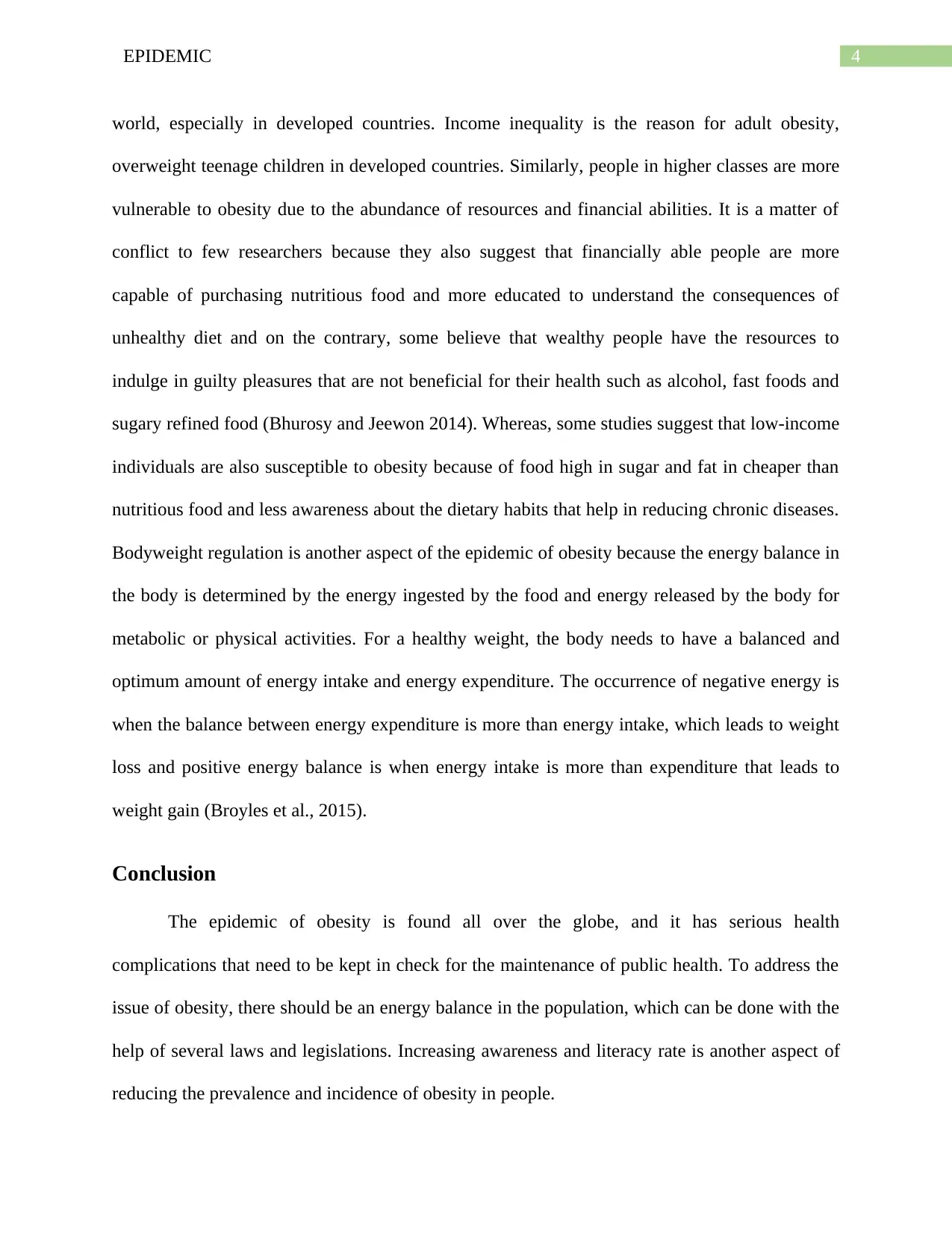
4EPIDEMIC
world, especially in developed countries. Income inequality is the reason for adult obesity,
overweight teenage children in developed countries. Similarly, people in higher classes are more
vulnerable to obesity due to the abundance of resources and financial abilities. It is a matter of
conflict to few researchers because they also suggest that financially able people are more
capable of purchasing nutritious food and more educated to understand the consequences of
unhealthy diet and on the contrary, some believe that wealthy people have the resources to
indulge in guilty pleasures that are not beneficial for their health such as alcohol, fast foods and
sugary refined food (Bhurosy and Jeewon 2014). Whereas, some studies suggest that low-income
individuals are also susceptible to obesity because of food high in sugar and fat in cheaper than
nutritious food and less awareness about the dietary habits that help in reducing chronic diseases.
Bodyweight regulation is another aspect of the epidemic of obesity because the energy balance in
the body is determined by the energy ingested by the food and energy released by the body for
metabolic or physical activities. For a healthy weight, the body needs to have a balanced and
optimum amount of energy intake and energy expenditure. The occurrence of negative energy is
when the balance between energy expenditure is more than energy intake, which leads to weight
loss and positive energy balance is when energy intake is more than expenditure that leads to
weight gain (Broyles et al., 2015).
Conclusion
The epidemic of obesity is found all over the globe, and it has serious health
complications that need to be kept in check for the maintenance of public health. To address the
issue of obesity, there should be an energy balance in the population, which can be done with the
help of several laws and legislations. Increasing awareness and literacy rate is another aspect of
reducing the prevalence and incidence of obesity in people.
world, especially in developed countries. Income inequality is the reason for adult obesity,
overweight teenage children in developed countries. Similarly, people in higher classes are more
vulnerable to obesity due to the abundance of resources and financial abilities. It is a matter of
conflict to few researchers because they also suggest that financially able people are more
capable of purchasing nutritious food and more educated to understand the consequences of
unhealthy diet and on the contrary, some believe that wealthy people have the resources to
indulge in guilty pleasures that are not beneficial for their health such as alcohol, fast foods and
sugary refined food (Bhurosy and Jeewon 2014). Whereas, some studies suggest that low-income
individuals are also susceptible to obesity because of food high in sugar and fat in cheaper than
nutritious food and less awareness about the dietary habits that help in reducing chronic diseases.
Bodyweight regulation is another aspect of the epidemic of obesity because the energy balance in
the body is determined by the energy ingested by the food and energy released by the body for
metabolic or physical activities. For a healthy weight, the body needs to have a balanced and
optimum amount of energy intake and energy expenditure. The occurrence of negative energy is
when the balance between energy expenditure is more than energy intake, which leads to weight
loss and positive energy balance is when energy intake is more than expenditure that leads to
weight gain (Broyles et al., 2015).
Conclusion
The epidemic of obesity is found all over the globe, and it has serious health
complications that need to be kept in check for the maintenance of public health. To address the
issue of obesity, there should be an energy balance in the population, which can be done with the
help of several laws and legislations. Increasing awareness and literacy rate is another aspect of
reducing the prevalence and incidence of obesity in people.

5EPIDEMIC
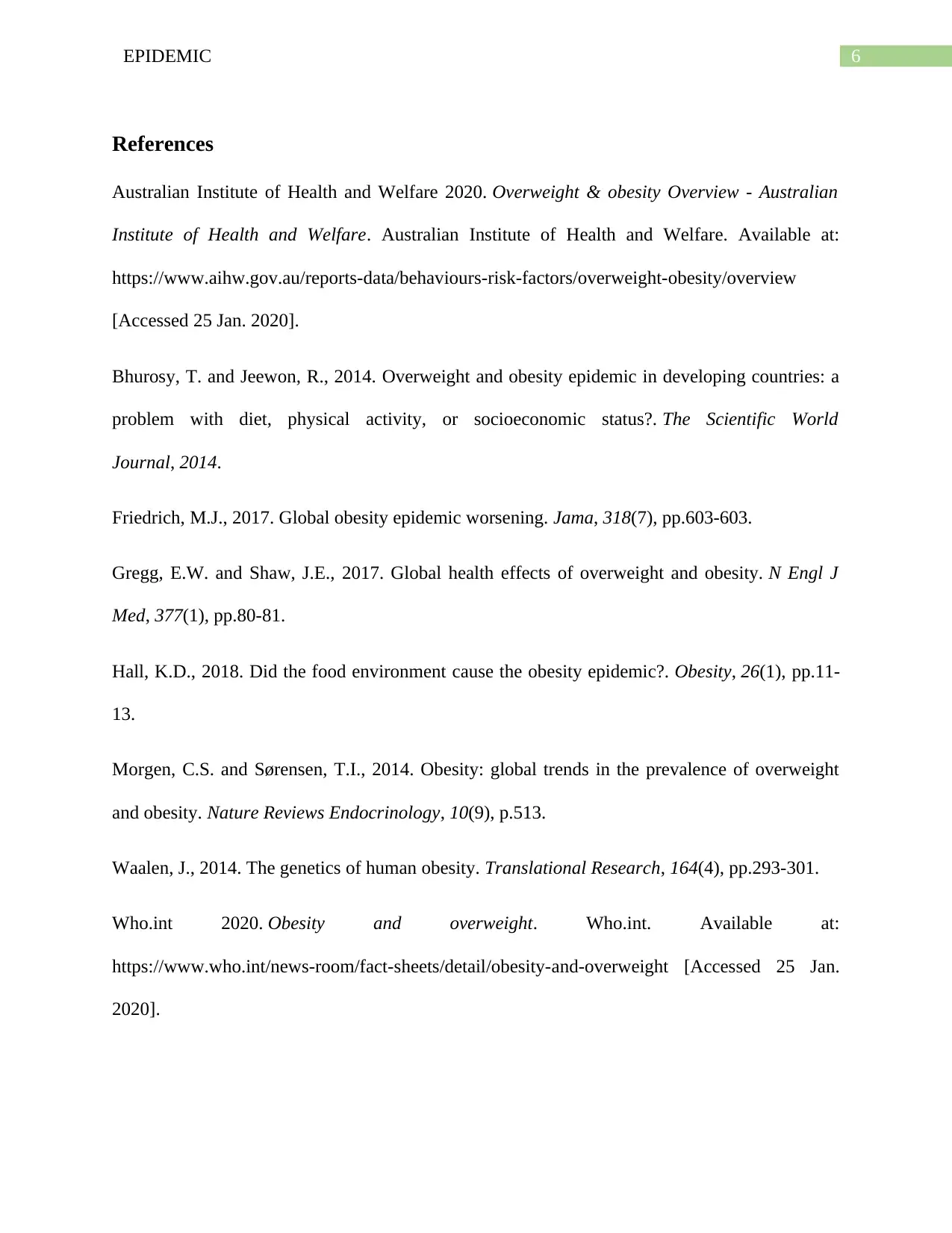
6EPIDEMIC
References
Australian Institute of Health and Welfare 2020. Overweight & obesity Overview - Australian
Institute of Health and Welfare. Australian Institute of Health and Welfare. Available at:
https://www.aihw.gov.au/reports-data/behaviours-risk-factors/overweight-obesity/overview
[Accessed 25 Jan. 2020].
Bhurosy, T. and Jeewon, R., 2014. Overweight and obesity epidemic in developing countries: a
problem with diet, physical activity, or socioeconomic status?. The Scientific World
Journal, 2014.
Friedrich, M.J., 2017. Global obesity epidemic worsening. Jama, 318(7), pp.603-603.
Gregg, E.W. and Shaw, J.E., 2017. Global health effects of overweight and obesity. N Engl J
Med, 377(1), pp.80-81.
Hall, K.D., 2018. Did the food environment cause the obesity epidemic?. Obesity, 26(1), pp.11-
13.
Morgen, C.S. and Sørensen, T.I., 2014. Obesity: global trends in the prevalence of overweight
and obesity. Nature Reviews Endocrinology, 10(9), p.513.
Waalen, J., 2014. The genetics of human obesity. Translational Research, 164(4), pp.293-301.
Who.int 2020. Obesity and overweight. Who.int. Available at:
https://www.who.int/news-room/fact-sheets/detail/obesity-and-overweight [Accessed 25 Jan.
2020].
References
Australian Institute of Health and Welfare 2020. Overweight & obesity Overview - Australian
Institute of Health and Welfare. Australian Institute of Health and Welfare. Available at:
https://www.aihw.gov.au/reports-data/behaviours-risk-factors/overweight-obesity/overview
[Accessed 25 Jan. 2020].
Bhurosy, T. and Jeewon, R., 2014. Overweight and obesity epidemic in developing countries: a
problem with diet, physical activity, or socioeconomic status?. The Scientific World
Journal, 2014.
Friedrich, M.J., 2017. Global obesity epidemic worsening. Jama, 318(7), pp.603-603.
Gregg, E.W. and Shaw, J.E., 2017. Global health effects of overweight and obesity. N Engl J
Med, 377(1), pp.80-81.
Hall, K.D., 2018. Did the food environment cause the obesity epidemic?. Obesity, 26(1), pp.11-
13.
Morgen, C.S. and Sørensen, T.I., 2014. Obesity: global trends in the prevalence of overweight
and obesity. Nature Reviews Endocrinology, 10(9), p.513.
Waalen, J., 2014. The genetics of human obesity. Translational Research, 164(4), pp.293-301.
Who.int 2020. Obesity and overweight. Who.int. Available at:
https://www.who.int/news-room/fact-sheets/detail/obesity-and-overweight [Accessed 25 Jan.
2020].
Paraphrase This Document
Need a fresh take? Get an instant paraphrase of this document with our AI Paraphraser
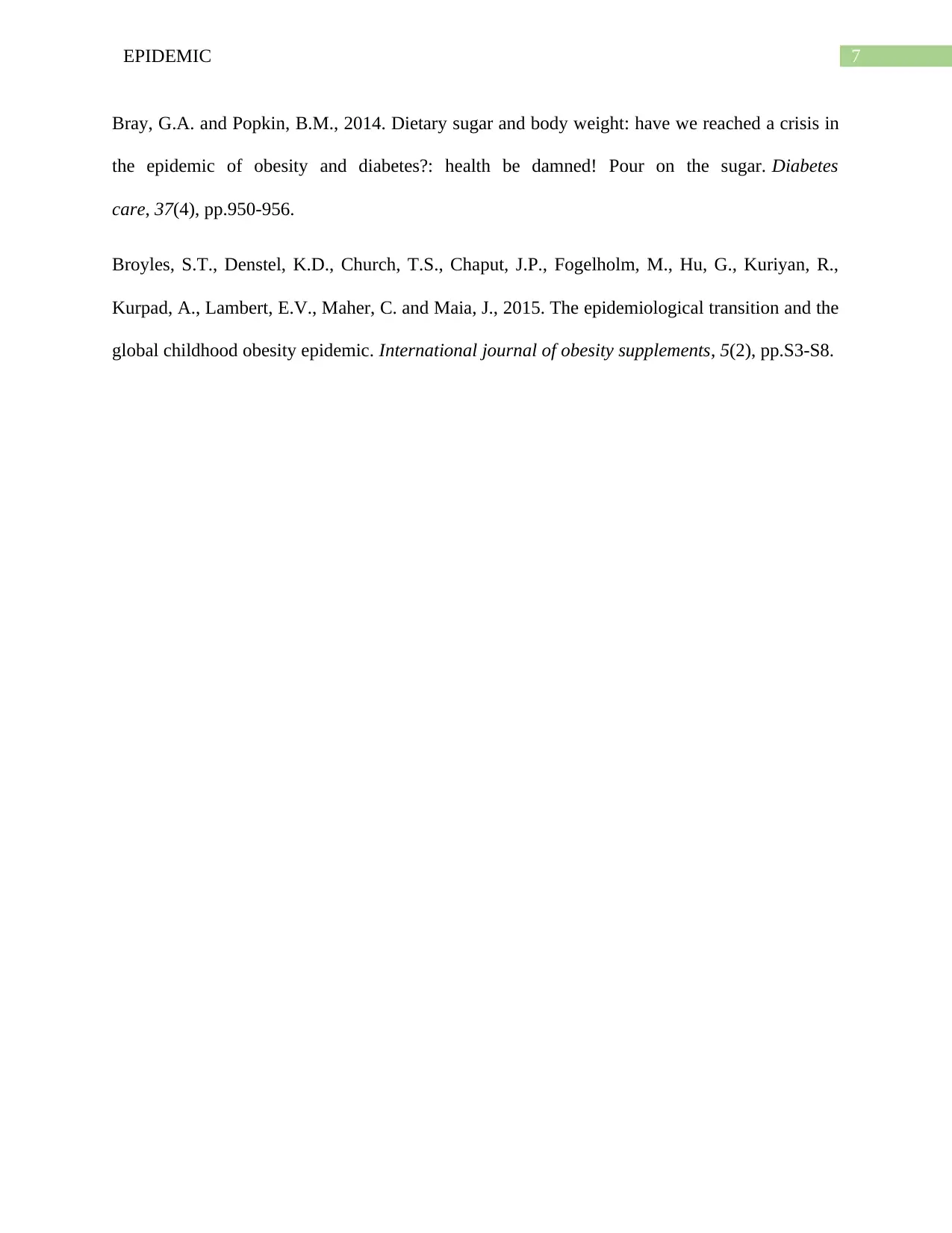
7EPIDEMIC
Bray, G.A. and Popkin, B.M., 2014. Dietary sugar and body weight: have we reached a crisis in
the epidemic of obesity and diabetes?: health be damned! Pour on the sugar. Diabetes
care, 37(4), pp.950-956.
Broyles, S.T., Denstel, K.D., Church, T.S., Chaput, J.P., Fogelholm, M., Hu, G., Kuriyan, R.,
Kurpad, A., Lambert, E.V., Maher, C. and Maia, J., 2015. The epidemiological transition and the
global childhood obesity epidemic. International journal of obesity supplements, 5(2), pp.S3-S8.
Bray, G.A. and Popkin, B.M., 2014. Dietary sugar and body weight: have we reached a crisis in
the epidemic of obesity and diabetes?: health be damned! Pour on the sugar. Diabetes
care, 37(4), pp.950-956.
Broyles, S.T., Denstel, K.D., Church, T.S., Chaput, J.P., Fogelholm, M., Hu, G., Kuriyan, R.,
Kurpad, A., Lambert, E.V., Maher, C. and Maia, J., 2015. The epidemiological transition and the
global childhood obesity epidemic. International journal of obesity supplements, 5(2), pp.S3-S8.
1 out of 8
Related Documents
Your All-in-One AI-Powered Toolkit for Academic Success.
+13062052269
info@desklib.com
Available 24*7 on WhatsApp / Email
![[object Object]](/_next/static/media/star-bottom.7253800d.svg)
Unlock your academic potential
© 2024 | Zucol Services PVT LTD | All rights reserved.





